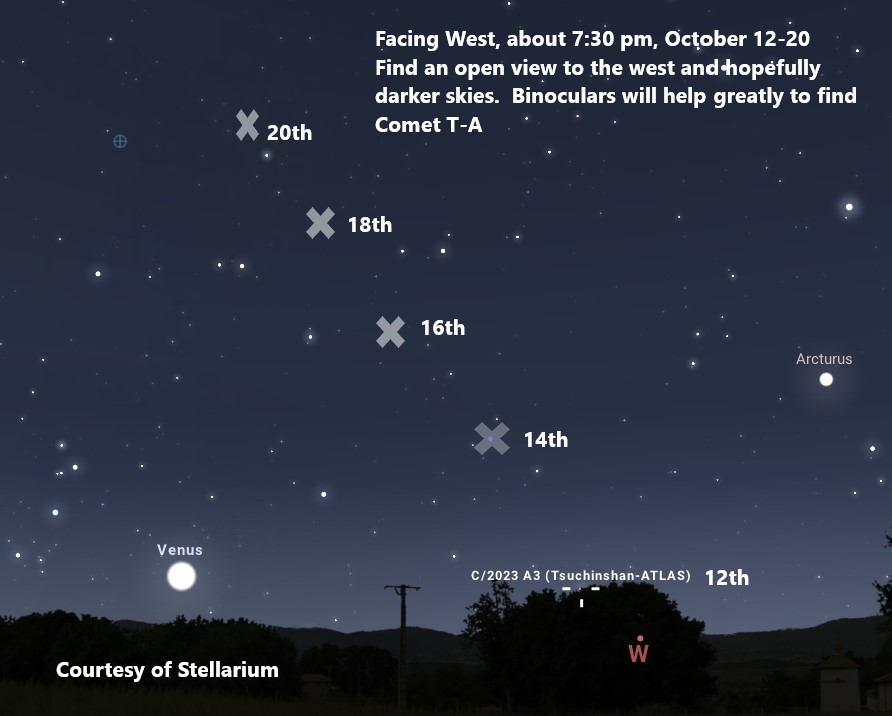CATCH A COMET’S TALE??
For about the last year and a half, I have circled October 2024 on my calendar. It will be the big month for the visibility for a new comet that you might have read about on social media. This comet was imaged by the Purple Mountain Observatory (the Mandarin name pronounced choo-chin-shahn) in China on January 9, 2023, but was then lost until confirmed by the Asteroid Terrestrial-Impact Last Alert System (ATLAS) on February 22 of that year. As the third comet confirmed in 2023, it received the designation of C/2023 A3 (Tsuchinshan-ATLAS or T-A). From now on in this blog post, I am going to refer to this object as Comet T-A. Some 600,000 times too dim to see with the naked eye at its discovery distance of nearly 700,000,000 miles from Earth, the comet’s orbit was soon determined by repeated observation. It turns out that T-A will pass a relatively close 36 million miles from the Sun at its perihelion on Sept. 27 and 44 million miles from Earth on October 12. Stargazers like me were depressed to learn of a plateau in T-A’s brightness this past spring, dampening expectations of a fine show. In fact, it was briefly thought by some experts that the comet was disintegrating like several others have done, but T-A resumed brightening late this summer.
The current “baseline” prediction is that T-A will attain a total brightness of second or third magnitude at its peak from now until close to mid October. This would be fairly equal to the total brightness of most of the stars in the Big Dipper. From dark sky locations, the comet might be dimly seen to the naked eye, and using binoculars an impressive tail might be seen. Digital cameras could provide even better images. This would be a cool treat for me as a stargazer, but I wasn’t sure if T-A would be worth explaining in this blog, to a general audience.
However, St. Louis astronomer Joe Marcus realized that T-A would be approaching at the right angle towards Sun and Earth that it might experience a lot of forward scattering from our point of view. This might be similar to how your breath can be dimly seen on a cold morning but appears much brighter if lit at just the right angle by the Sun. This will be most evident for several days around October 9th, when T-A will appear most nearly between the Earth and Sun, with a temporary enhancement of more than a hundred-fold possible on that date itself. Although most of this will take place when T-A will appear too close to the Sun to be easily seen, some of the effect might still persist into the time when the comet starts to emerge into better view, beginning around the 12th.

A man’s breath is seen on a cold day, lit up brightly by forward scattering. Courtesy of Sky & Telescope
There is also a possibility of spotting the comet from now until the first few days of October, in the morning sky. Due to the comet being seen against the background of dawn and the forward scattering not being too significant yet, this will be much more difficult than the evening period that opens a couple of weeks later, but I am including it because T-A is getting more and more attention. Find a spot with an open view to the eastern horizon and look around 6 am. Binoculars will be needed. Probably the best chance for a morning observation will be on the mornings of September 30 and October 1 when the comet will be fairly near a very thin crescent moon- look two to three fist-widths from the Moon, close to the eastern horizon near 6 am, using the map here.

Comet T-A MIGHT be spotted very low in the eastern sky in the dawn on the mornings for about the next week. The moon could help you locate on he mornings of September 30, and October 1.
If you don’t feel like getting up early for what will definitely be a difficult observation, the map below shows that the chances should be much better and at a much more convenient hour for most people, beginning around Oct. 12. Now you will need an open view to the west and use the line from brilliant Venus to the bright star Arcturus to make your estimate of where T-A should be. If at all possible head to a darker sky location, and bring binoculars. T-A will probably look like a fuzzy spot. Can you see a tail, possibly pointing to the upper left. If the comet is bright enough and the sky dark enough, can you see it with your unaided eyes? The comet is likely to be brightest at the beginning of the period covered by the map, but very low and seen against the twilight background. Each night, there will be two competing effects- T-A will be moving away from the Earth-Sun line, causing it to appear higher in the sky, but also fading steadily as it begins its long journey towards the outer solar system. Also, any forward-scattering bonus will diminish fast. I think the best balance of these factors might be around the 14th, but I plan to be watching each clear night, around 7:30 pm here in St. Louis, Try getting an image of T-A on your smartphone, if you have a setting that allow you to take a time exposure, or if you have a DSLR camera, that would be even better! I would enjoy hearing from any of you who found the comet with this information. E-mail me at Richard_fefferman@nps.gov with your results. There are already some very impressive images out there of T-A, but bear in mind that most are take by experienced stargazers with fine equipment and usually from dark sky sites.

Don’t miss our last Gateway to the Stars event of 2024 with a Ranger led interpretive program preceding free telescope viewing of the Moon, Saturn, and possibly Comet T-A. In the annual “Ghosts of the Arch Grounds” presentation, learn about the various “incarnations” of the area as it evolved from a French-style fur trading post to thriving riverfront district to the present national park site. Great and catastrophic events such as the founding of St. Louis, building of the Arch, the Great St. Louis Fire, and a horrible cholera epidemic are discussed, along with the fortunes and misfortunes of people such as Thomas Targee, James Eads, Eero Saarinen, Percy Green, Kenneth Swyers and others. This program is scheduled to be presented on the Entrance Plaza at 6:30 pm on Friday, October 18th and be followed by the telescope viewing. In the event of inclement weather, the “Ghost” talk will be moved inside the Visitor Center and the viewing cancelled. There will be no access to the Museum, Gift Shop, or tram ride in this case. Call 314-655-1704 on the afternoon of the 18th to check on the status of the event, or if you have any questions.
